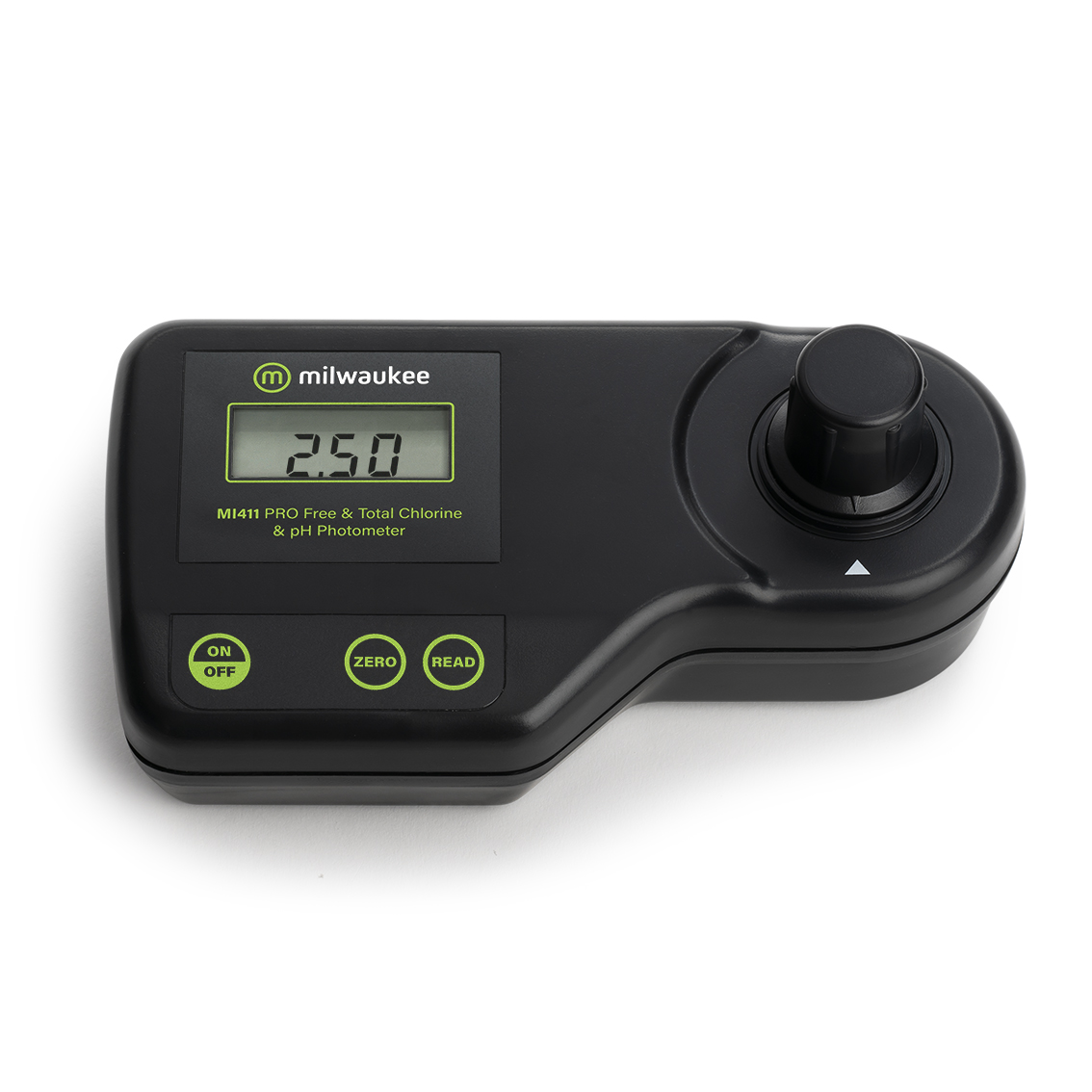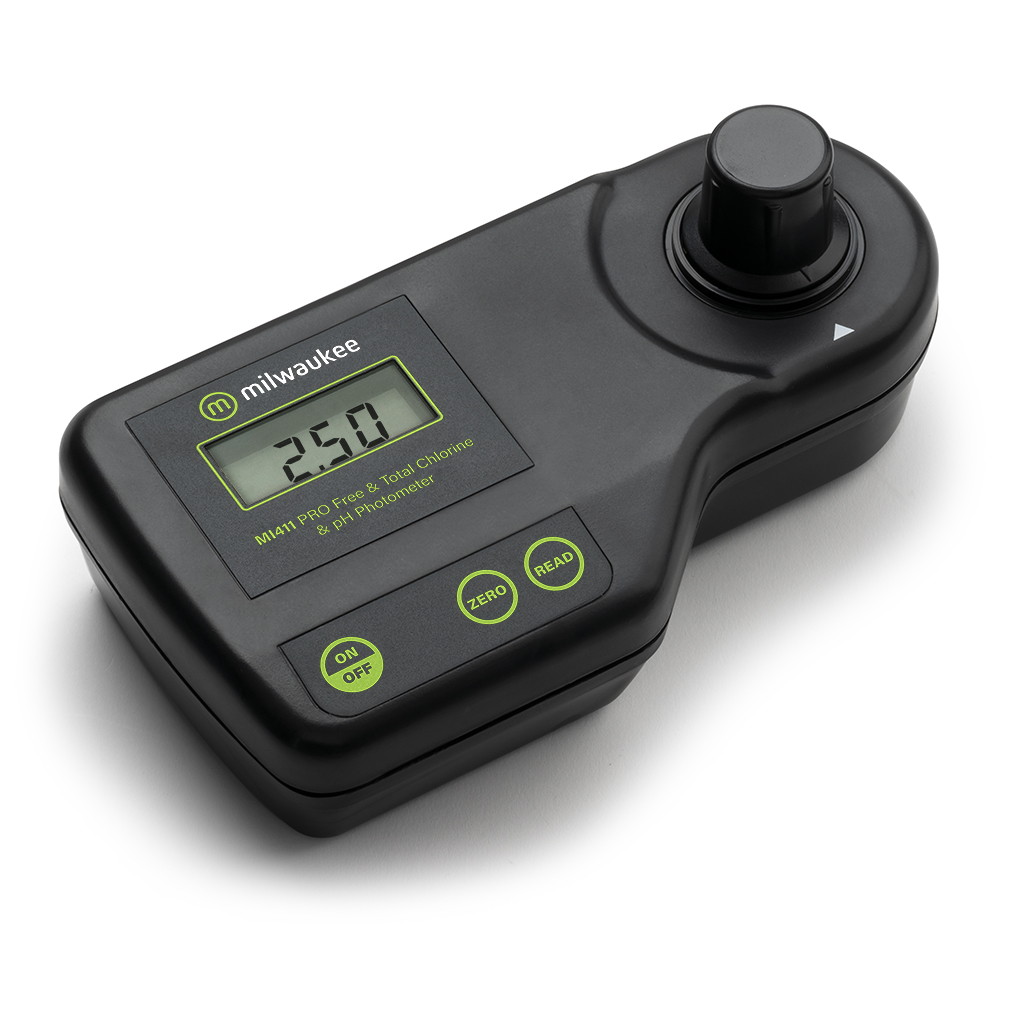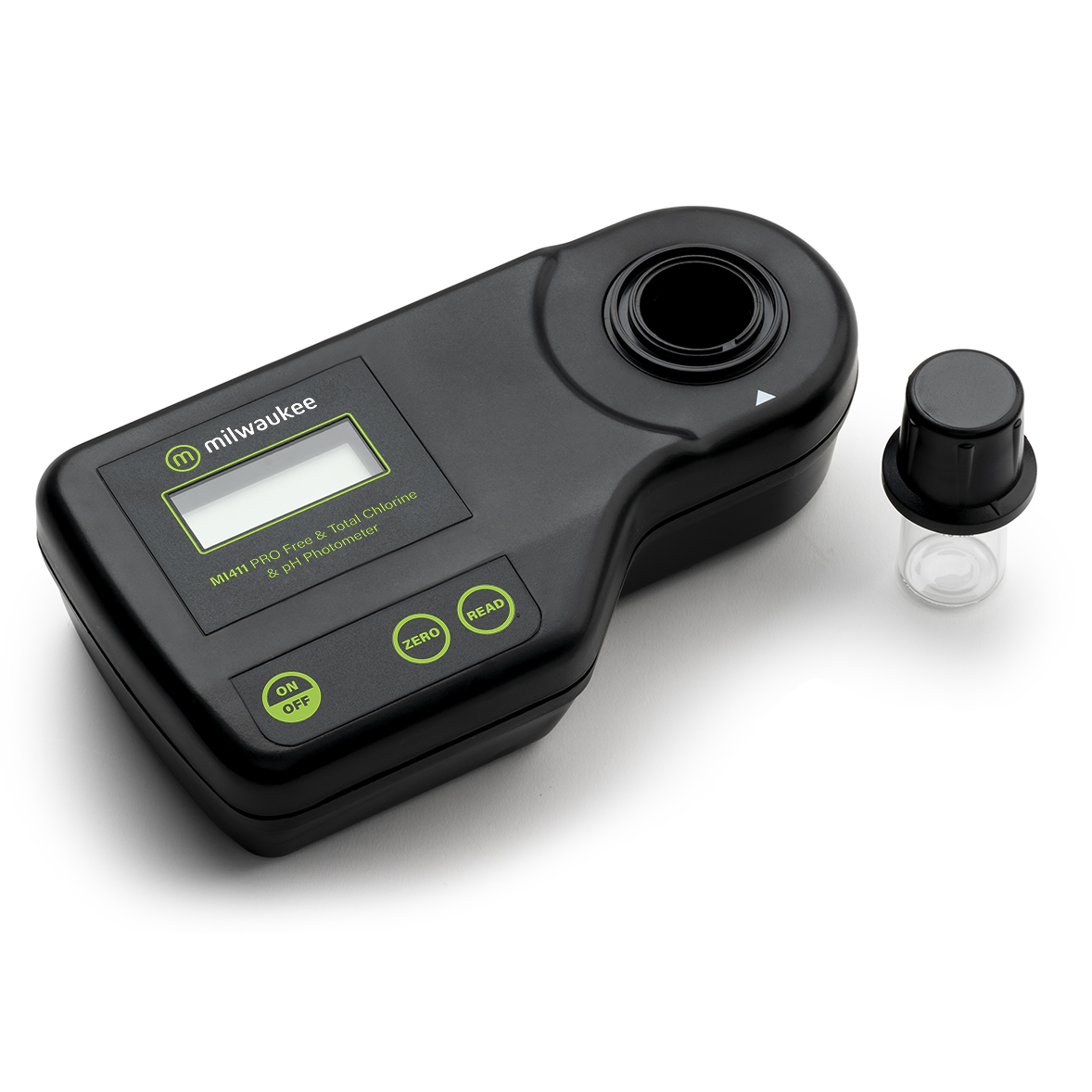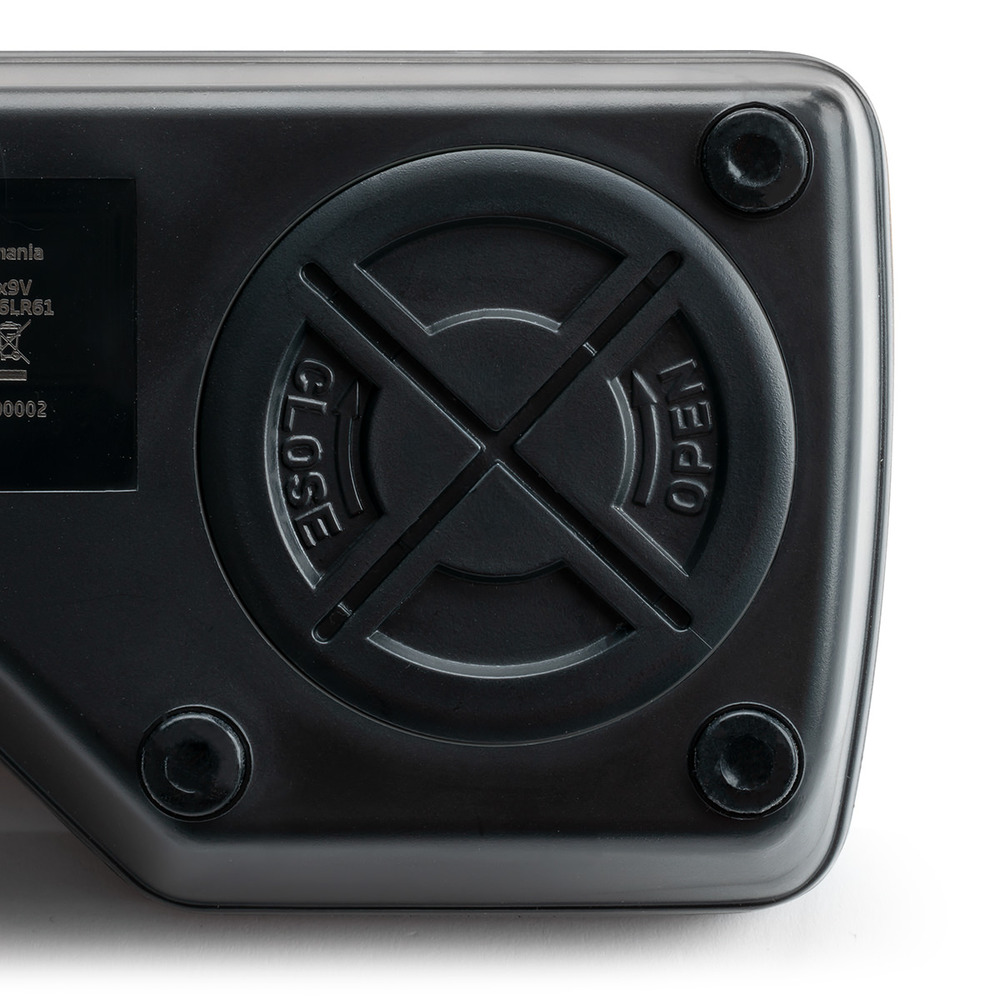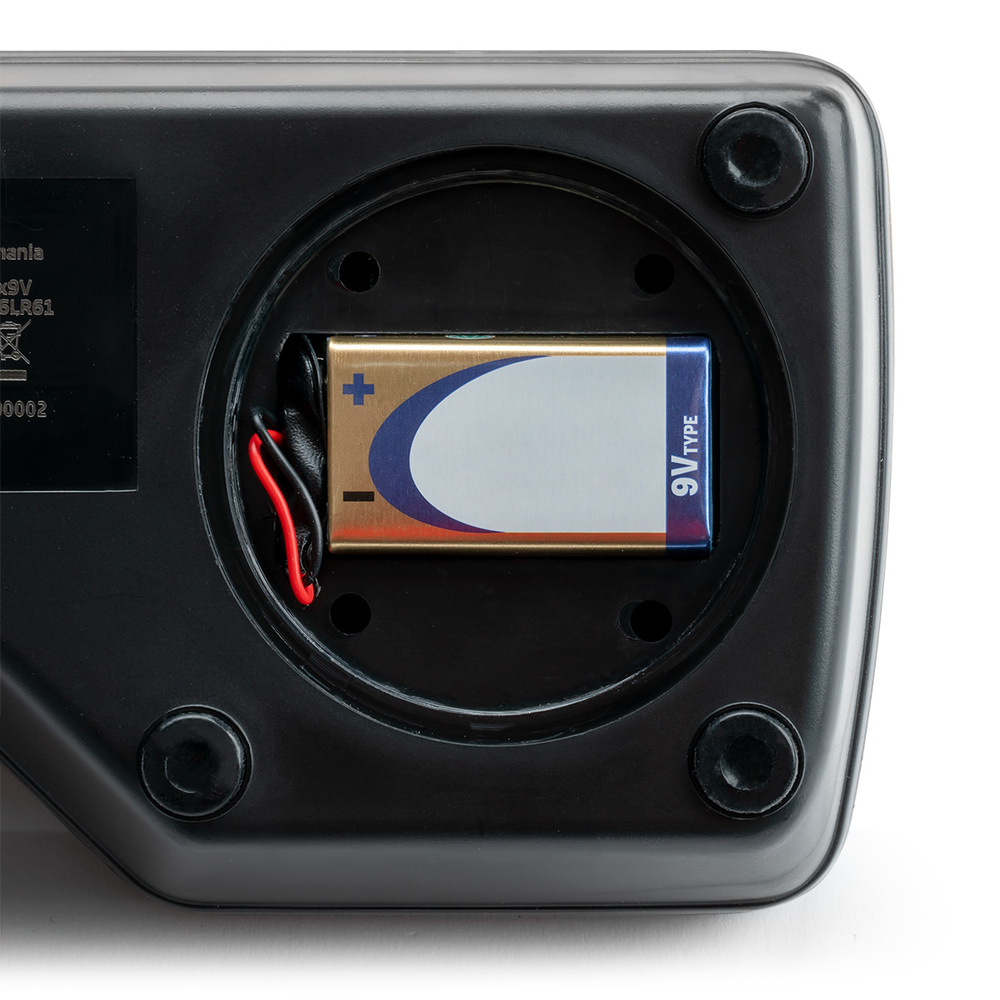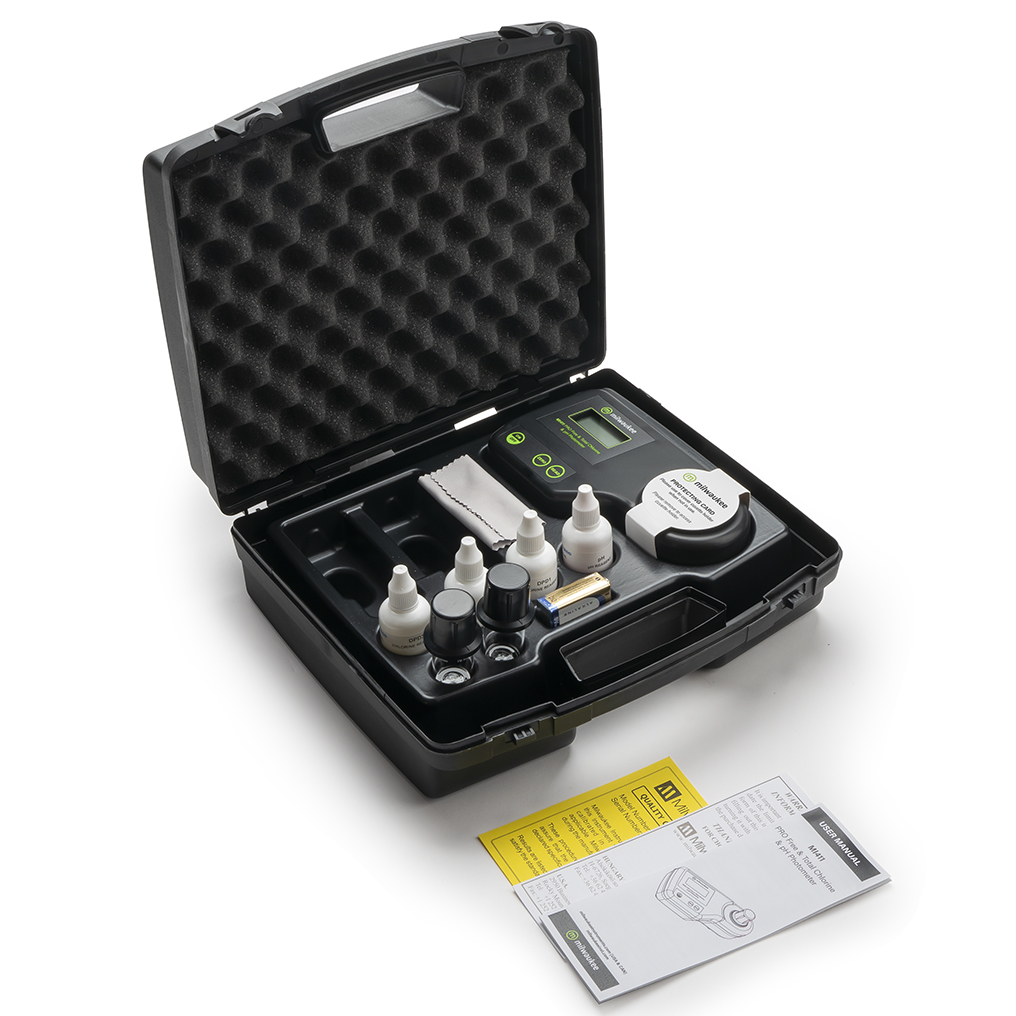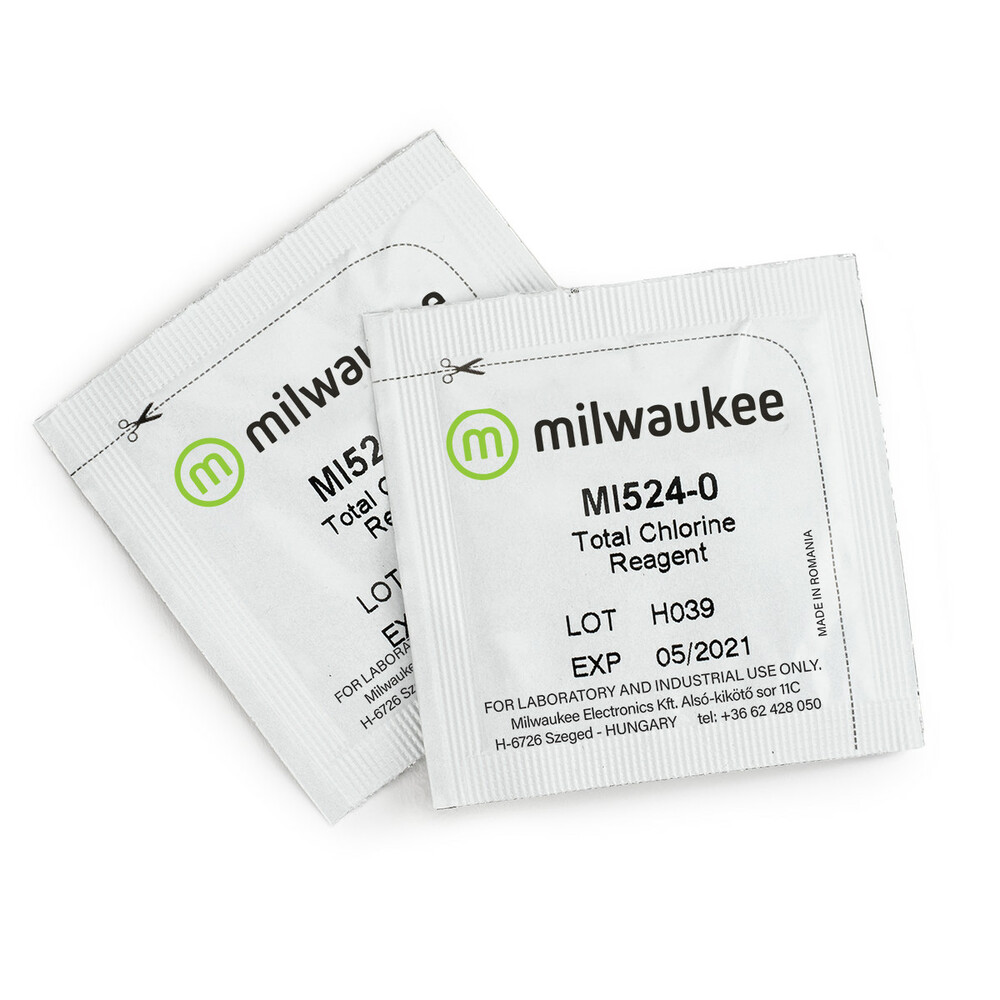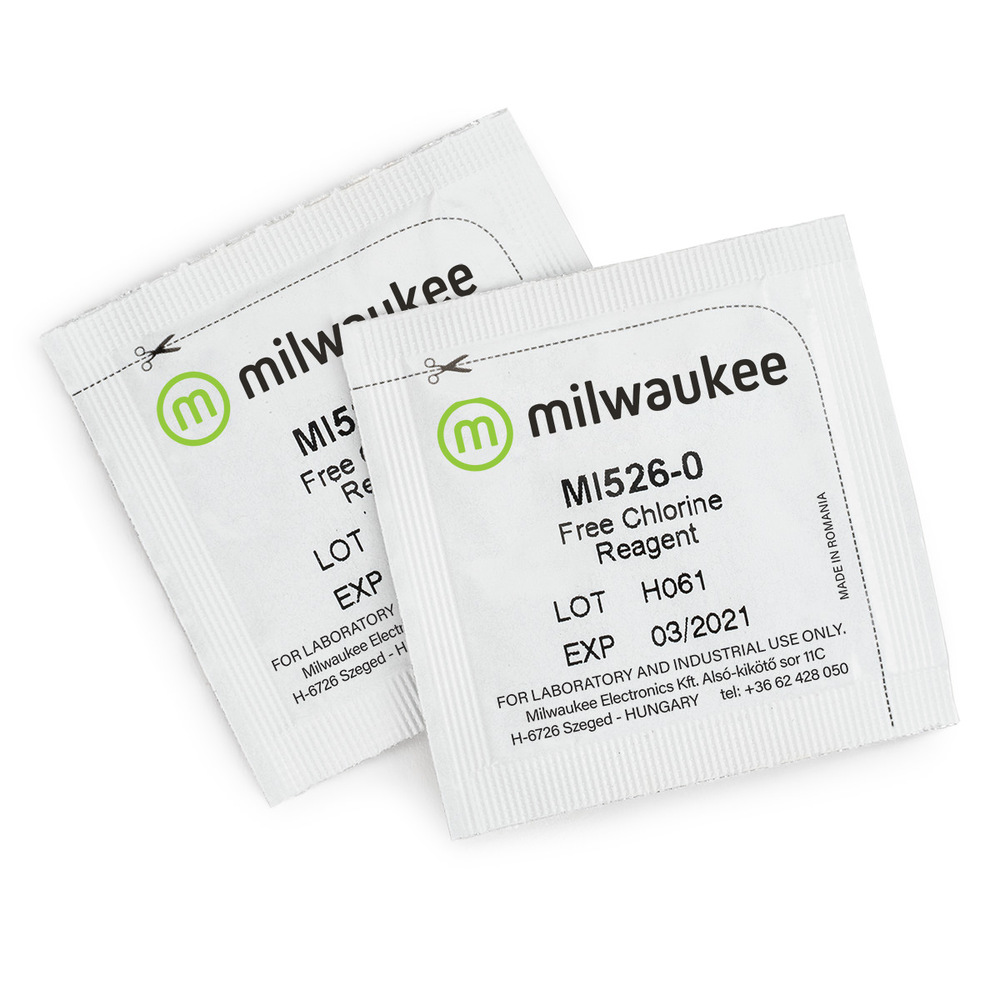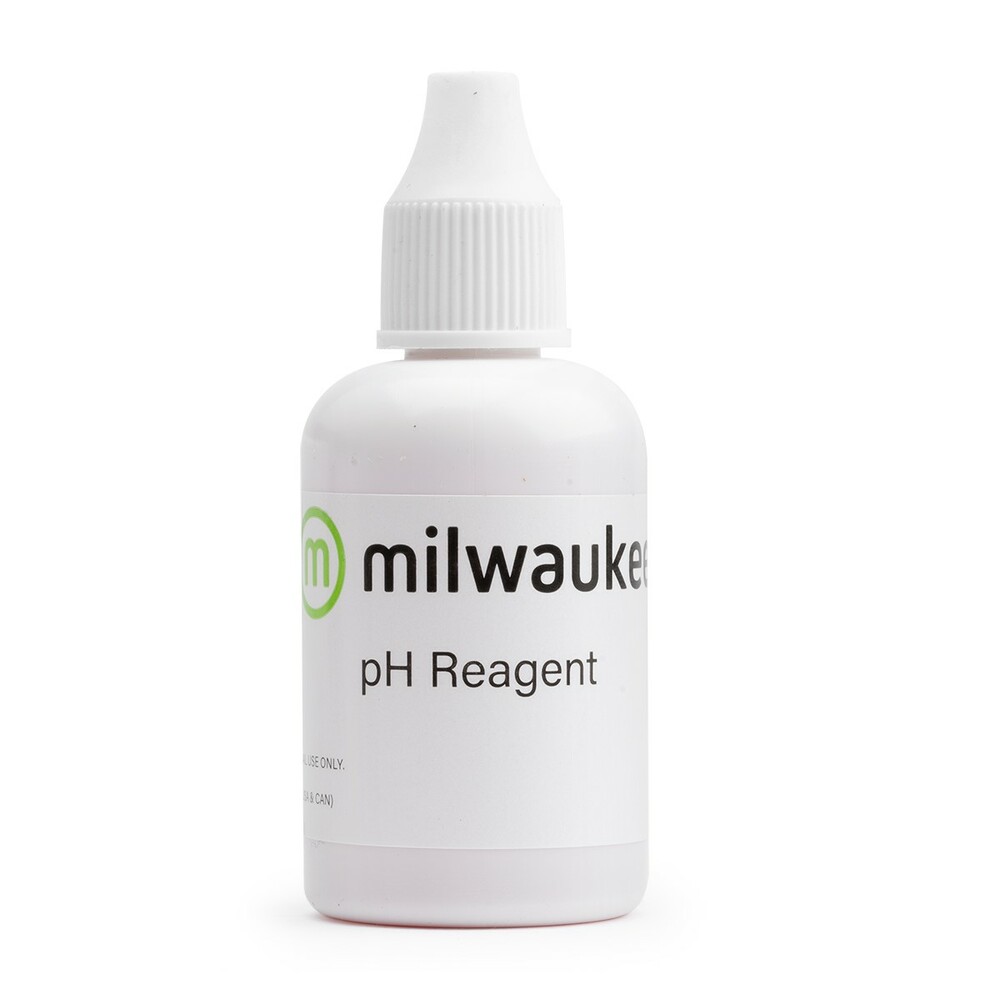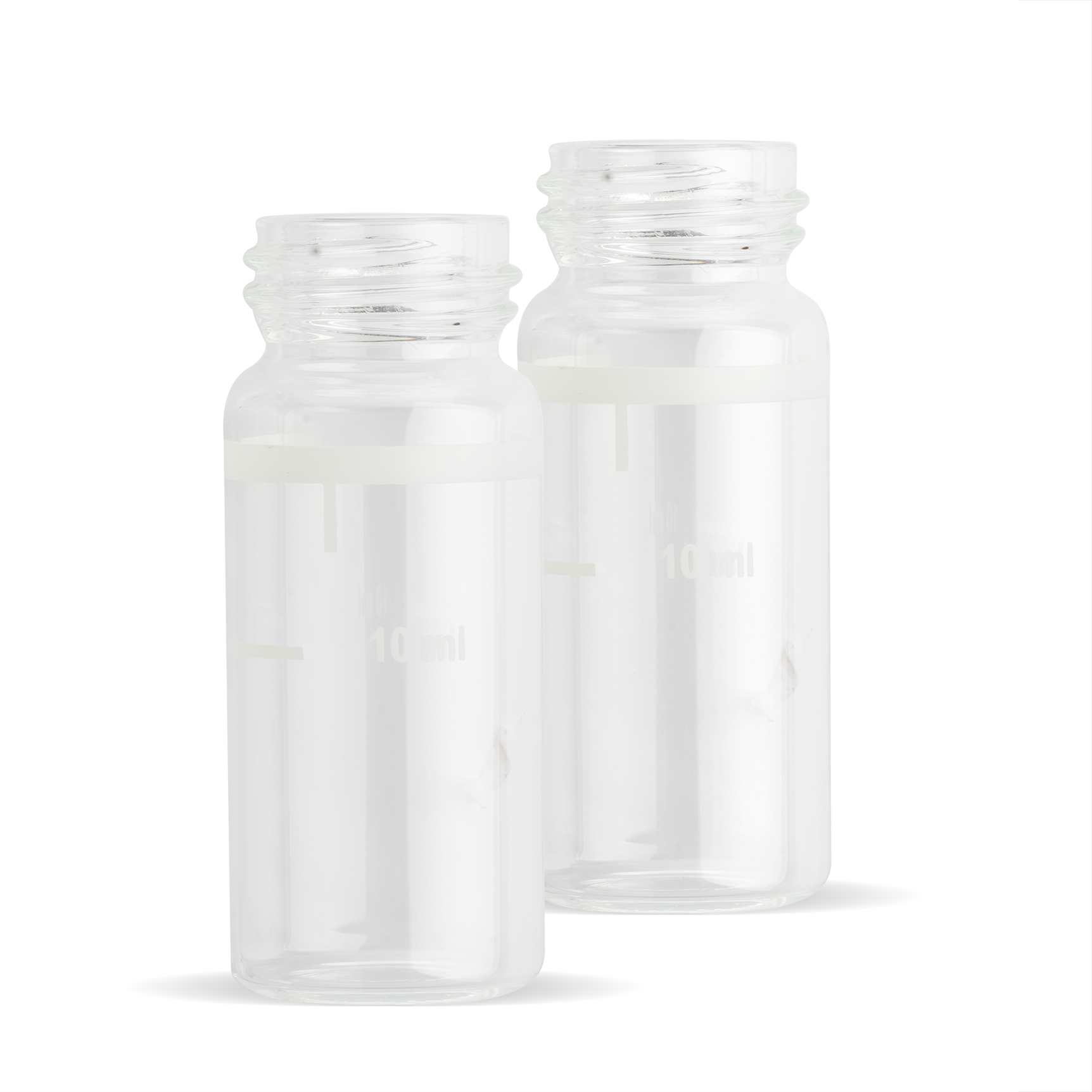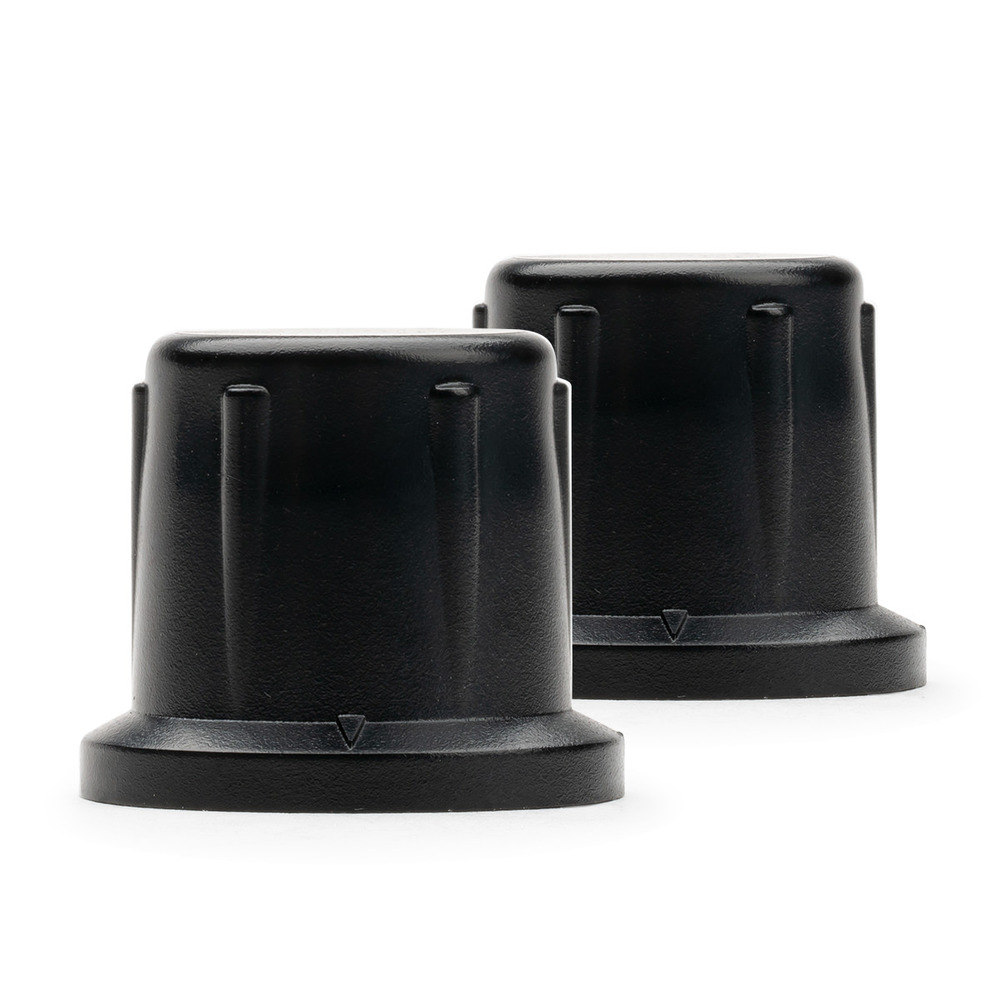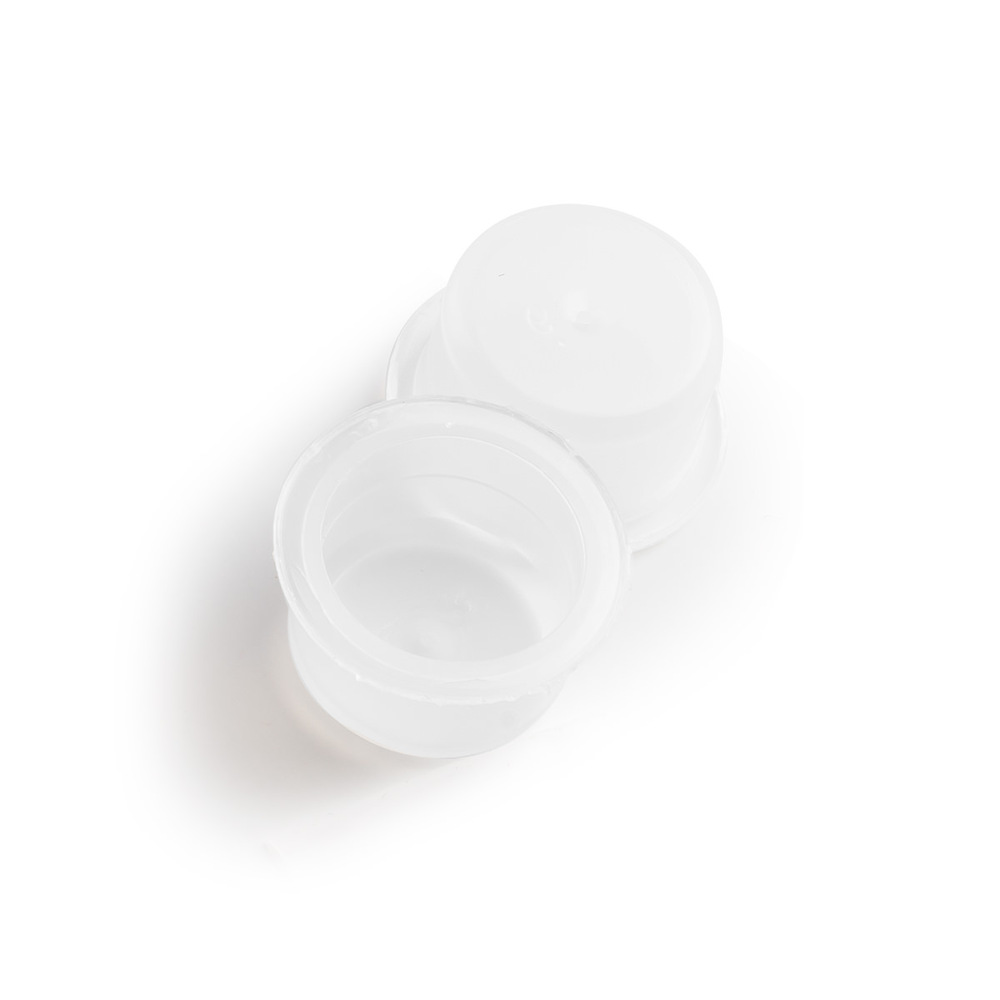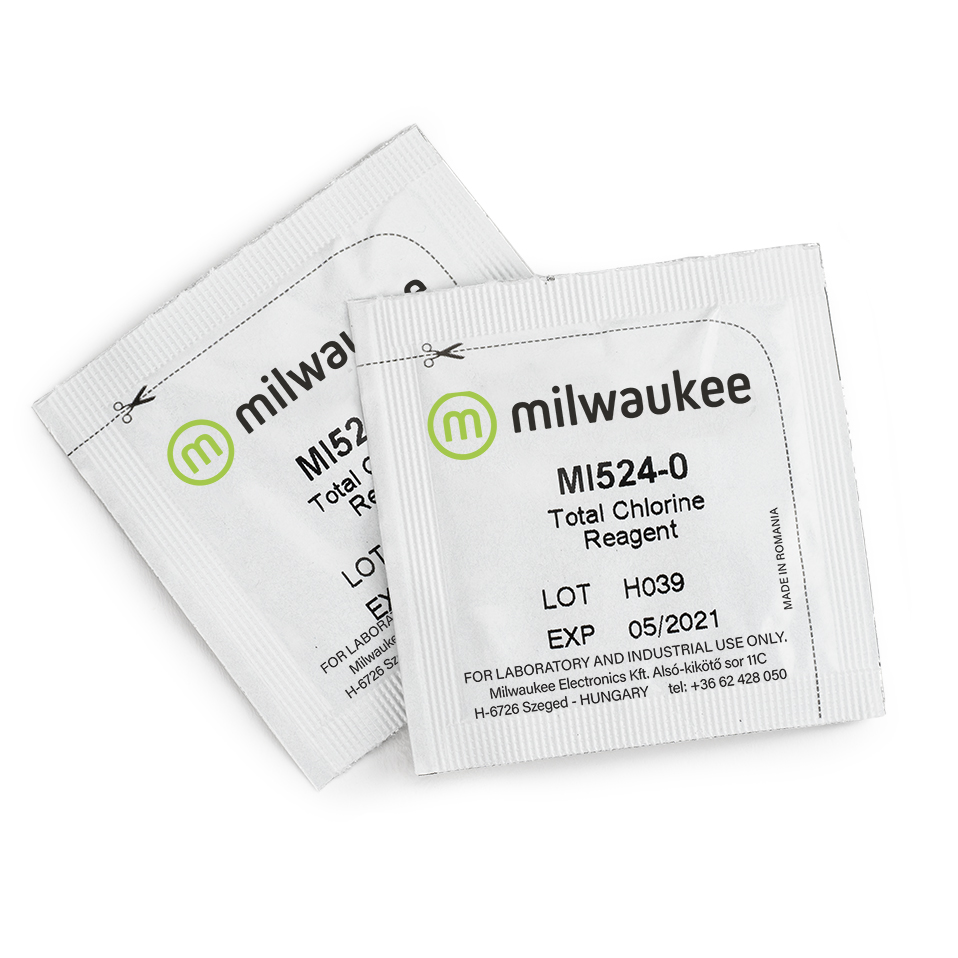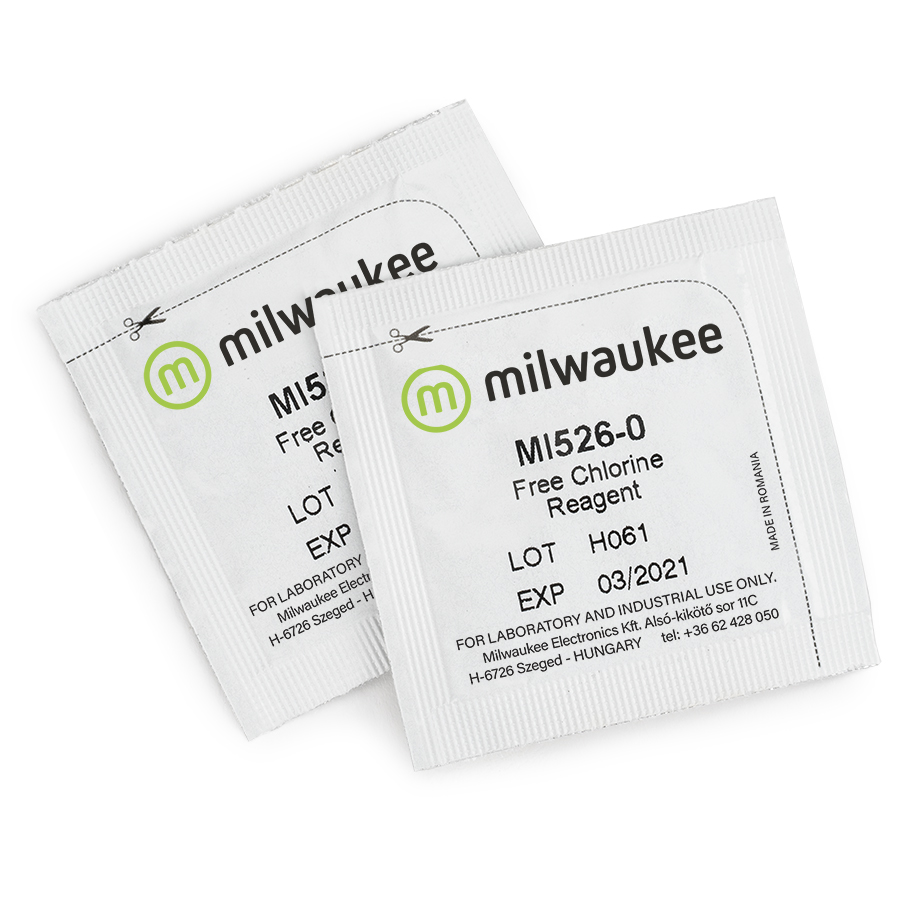Your shopping cart is currently empty.
Milwaukee MI411 pH and Free & Total Chlorine PRO Photometer
Milwaukee MI411 PRO pH and Free & Total Chlorine Photometer – Accurate, Portable Water Quality Testing
When precision matters in water quality control – whether you're ensuring safe drinking water, maintaining perfect pool conditions, or managing sanitation in food processing – the Milwaukee MI411 PRO is your reliable partner. Combining advanced photometric technology with pH measurement capability, this compact, dual-parameter instrument is built for professionals who demand laboratory-grade results in a field-ready format.
The MI411 PRO goes beyond basic testing. It gives you the confidence of accurate pH readings and precise measurements of both free and total chlorine, critical parameters in water disinfection and treatment processes. Housed in a rugged, portable design and supplied with ready-to-use reagents and calibration standards, the MI411 PRO makes it easy to stay compliant with water safety regulations – anytime, anywhere.
Whether you’re a municipal water technician, food safety inspector, pool operator, or aquaculture manager, the MI411 PRO is designed to simplify your workflow while elevating your quality control.
Why Choose the Milwaukee MI411 PRO?
- 3-in-1 Measurement Capability: Simultaneously measure pH, free chlorine, and total chlorine – key indicators for water treatment, disinfection, and safety.
- Lab-Grade Accuracy: ±0.3 pH accuracy and high-resolution photometry for chlorine (0.01 mg/L), ensuring precise and repeatable results across applications.
- User-Friendly Interface: Easy-to-read LCD display, intuitive keypad, and guided measurement process simplify operation for all user levels.
- Field-Ready Design: Lightweight, battery-operated (9V included) with a hard carrying case and accessories for portable, on-the-go testing.
- Ready to Use: Comes with pre-measured powder reagents (20 tests per parameter), pH 7.01 calibration solution, cuvettes, stir bar, and instructions.
- Reliable Calibration: Single-point calibration for pH with automatic temperature compensation ensures fast setup and reliable performance.
Applications
The versatility of the MI411 PRO makes it a valuable tool across industries:
Drinking Water & Municipal Treatment
Ensure water safety and regulatory compliance by monitoring chlorine levels and pH in distribution systems and treatment plants.
Swimming Pools & Spas
Accurately test disinfectant levels and maintain proper pH to protect swimmers and extend equipment lifespan.
Food & Beverage Processing
Monitor chlorine and pH in rinse water and cleaning solutions to comply with hygiene standards and prevent cross-contamination.
Aquaculture & Fisheries
Protect aquatic life by verifying that water conditions remain free of harmful chlorine levels and within ideal pH ranges.
Wastewater Treatment
Track chlorine residuals and pH in treated effluent to meet environmental discharge limits and system efficiency targets.
Industrial Water Systems
Control corrosion, scale, and biofouling in boiler feed water, cooling towers, and CIP (Clean-in-Place) systems with accurate pH and chlorine analysis.
Proper Care & Maintenance
Extend the Life of Your Instrument & pH Electrode
To ensure the long-term accuracy and reliability of your MI411 PRO, proper care and routine maintenance are essential:
pH Electrode Maintenance
- Storage: Always store the pH electrode in pH storage solution or calibration buffer (not in DI or tap water) to maintain sensitivity and prevent clogging of the reference junction. Use the probe cap filled with solution and store upright.
- Cleaning: Regularly soak the probe in cleaning solution, especially after exposure to high-organic or dirty samples, to prevent buildup and degradation of accuracy.
- Calibration: Perform routine single-point calibration using the included pH 7.01 buffer. Recalibrate after cleaning or prolonged storage for optimal performance.
Photometer Care
- Cuvette Cleaning: Keep glass cuvettes free from smudges and residues. Clean thoroughly and handle with a soft cloth to avoid measurement errors.
- Reagent Handling: Use only Milwaukee’s high-quality powder reagents. Always follow instructions for dosing and mixing to ensure test validity.
- Battery Replacement: Replace the 9V battery when the low battery indicator appears to avoid interruptions during testing.
With proper handling, the MI411 PRO will deliver years of precise, dependable water quality measurements.
Optimize your water testing routine with the Milwaukee MI411 PRO – compact, dependable, and engineered for professionals who demand precision in the field.
Specifications
Application
Drinking Water Treatment & Distribution
In the treatment and distribution of drinking water, ensuring safe, clean, and compliant water is not just a public health responsibility – it’s a legal and regulatory requirement. The Milwaukee MI411 PRO Photometer plays a critical role in verifying water safety by precisely measuring free and total chlorine, which are essential disinfectants used to eliminate pathogens in water, and pH, which directly influences chlorine’s effectiveness and corrosion control in pipes.
Maintaining the correct chlorine residual – typically between 0.2 and 1.0 mg/L depending on local standards – ensures that water remains disinfected throughout the distribution system. However, chlorine effectiveness is pH-dependent: at higher pH levels, chlorine becomes less potent as a disinfectant. Therefore, continuous monitoring of both chlorine and pH is necessary to ensure disinfection efficacy, safeguard public health, and protect infrastructure from pH-induced corrosion or scaling.
This is especially vital for:
- Water utilities and municipal water treatment plants that distribute to thousands of households.
- Bottled water facilities that must comply with strict bottling and purity regulations.
- Field operators or quality control personnel who conduct spot checks at different distribution points.
By using the MI411 PRO, technicians can quickly validate compliance with WHO and EPA standards – 0even in remote locations – ensuring water delivered to the public is safe, balanced, and properly treated.
How to Use the MI411 PRO for Drinking Water Monitoring
Prepare Your Sample
- Collect a fresh water sample in a clean cuvette (provided).
- Rinse the cuvette with the sample water before final collection to avoid contamination.
Testing Free Chlorine
- Add one packet of free chlorine reagent to the cuvette containing 10 mL of sample water.
- Close the cuvette with the cap and gently swirl or use the magnetic stir bar (included) to dissolve the powder completely.
- Insert the cuvette into the photometer.
- Press the appropriate button to begin the measurement.
- Read and record the result displayed in mg/L (ppm).
Testing Total Chlorine
- Use a new cuvette or thoroughly rinse the previous one.
- Add one packet of total chlorine reagent to a new 10 mL sample.
- Follow the same steps as above: mix well, insert into the instrument, and read the result.
Measuring pH
- Rinse and insert the pH electrode into a separate 10 mL sample.
- Allow the reading to stabilize, then record the pH value.
- For best results, regularly calibrate the pH probe using the included pH 7.01 buffer solution.
Rinse Components
- Thoroughly rinse all cuvettes and the electrode with distilled water after use.
Maintenance Tip:
Always store the pH probe in storage solution after use and keep reagents in a dry, cool place to maintain their accuracy.
Swimming Pools & Spas
Maintaining the right water chemistry in pools and spas is critical for both health safety and user comfort. Improper chlorine levels or imbalanced pH can lead to a host of problems – from skin and eye irritation to ineffective disinfection and even structural damage to the pool or spa system.
The Milwaukee MI411 PRO is an indispensable tool for facility managers, pool maintenance technicians, hotel operators, spa owners, and residential pool caretakers. It provides fast, accurate measurements of free chlorine, total chlorine, and pH, three essential parameters for keeping pool and spa water safe, clear, and comfortable.
- Free chlorine is the active form that disinfects the water. If levels fall too low, bacteria, algae, and other pathogens can grow unchecked.
- Total chlorine includes both free chlorine and combined chlorine (chloramines), which can cause unpleasant odors and skin irritation if allowed to build up.
- pH affects how effectively chlorine disinfects. A pH that's too high reduces chlorine's sanitizing power, while too low a pH can lead to corrosion and eye irritation.
By using the MI411 PRO, pool and spa operators can stay on top of water chemistry, respond quickly to imbalances, and ensure regulatory compliance for commercial facilities. This protects both users’ health and the integrity of the pool system.
How to Use the MI411 PRO for Pool & Spa Maintenance
Collect a Water Sample
- Rinse a clean cuvette with pool/spa water to avoid cross-contamination.
- Fill the cuvette with 10 mL of sample water.
Measure Free Chlorine
- Add one free chlorine reagent packet to the sample.
- Gently swirl or stir with the provided magnetic stir bar until the powder is fully dissolved.
- Place the cuvette into the MI411 PRO photometer and initiate the test.
- The free chlorine level will be displayed in mg/L (ppm).
Measure Total Chlorine
- Use a new or well-rinsed cuvette with a fresh 10 mL water sample.
- Add the total chlorine reagent packet, mix, insert into the photometer, and begin the test.
- Read and record the total chlorine value shown on the display.
Measure pH
- Rinse the pH electrode with distilled water and gently blot dry.
- Immerse it into a separate 10 mL water sample (not mixed with any reagent).
- Wait for the reading to stabilize and record the pH value.
Interpret Results
- Ideal free chlorine range: 1.0 – 3.0 mg/L for pools, 3.0 – 5.0 mg/L for spas.
- Ideal pH range: 7.2 – 7.6 for both pools and spas.
- If total chlorine is much higher than free chlorine, it indicates chloramine buildup – time to shock the pool.
Rinse & Store
- Clean cuvettes and the pH probe with distilled water after use.
- Store the pH electrode in storage solution.
- Keep reagents sealed and stored in a cool, dry place.
Food & Beverage Industry
In the food and beverage industry, water is more than just an ingredient – it’s a key component of sanitation protocols that ensure product safety and consumer health. Water is used throughout food production: from washing raw ingredients, to processing and cooking, to final equipment rinses. Maintaining proper free chlorine levels and pH balance in this water is essential for meeting hygiene standards, avoiding cross-contamination, and ensuring compliance with food safety regulations such as HACCP, FSMA, and EU food hygiene legislation.
- Free chlorine is widely used to disinfect wash water and food contact surfaces. If levels are too low, it may not effectively neutralize pathogens. If too high, it can leave unwanted chemical residues or negatively affect food quality.
- pH influences chlorine’s effectiveness and must be kept within a specific range (usually 6.5–7.5) to ensure disinfection is working at its best.
The Milwaukee MI411 PRO enables rapid, on-site testing of these critical parameters, giving food processors confidence that their sanitizing solutions are working effectively and safely. With precise digital readings and easy reagent-based testing, it eliminates the guesswork and subjectivity of manual test kits, making it ideal for:
- Meat and poultry facilities, where equipment sanitation and chill water control are vital.
- Breweries and dairies, which depend on ultra-clean process water to maintain flavor and product consistency.
- Fresh produce washing operations, where rinse water must meet microbial reduction requirements without leaving harmful residues.
By integrating the MI411 PRO into their quality control routines, food producers can reduce risk, meet audit requirements, and maintain a safe production environment.
How to Use the MI411 PRO in Food & Beverage Environments
Prepare Your Sample
- Take a 10 mL sample of wash water or rinse water in a clean cuvette.
- For accurate results, rinse the cuvette with the sample water before final collection.
Free Chlorine Measurement
- Add one free chlorine reagent packet to the cuvette.
- Mix gently using the magnetic stir bar or by swirling until fully dissolved.
- Place the cuvette in the photometer and press the measurement button.
- Read and record the displayed result in mg/L (ppm).
Total Chlorine Measurement (if needed)
- Use a fresh sample and repeat the same steps with the total chlorine reagent.
- This helps detect any buildup of chloramines or residual disinfectants in water reused for rinsing or surface sanitation.
pH Measurement
- Rinse the pH electrode with distilled water and insert it into a new 10 mL sample (no reagent added).
- Wait for the reading to stabilize and record the pH value.
- If testing ingredient water, ensure pH falls within the desired range for food compatibility.
Evaluate Compliance
- Compare results with internal safety protocols and regulatory limits (e.g., max chlorine residuals typically under 4.0 mg/L).
- Adjust chlorine dosing or replace sanitizing solutions as needed.
Clean & Store Equipment
- Rinse the pH probe and cuvettes with distilled water.
- Store the pH electrode in storage solution to maintain accuracy.
- Keep reagents sealed, labeled, and stored in a clean, dry environment away from food zones.
Aquaculture & Fish Hatcheries
Water quality management is the cornerstone of successful aquaculture. In fish farms, hatcheries, and ornamental breeding facilities, even minor fluctuations in pH or the presence of residual chlorine can have dramatic effects on aquatic life – impacting fish health, growth rates, reproduction, and overall system stability.
Unlike other industries, aquaculture environments are biologically active systems, meaning that every chemical imbalance can quickly lead to stress, disease outbreaks, or mortality events. Chlorine, while commonly used to disinfect incoming water, is toxic to fish even at low concentrations. Any residual free chlorine must be removed or confirmed absent before water is introduced to tanks or ponds. At the same time, pH stability is essential for biological processes such as respiration, digestion, and waste conversion by beneficial bacteria.
The Milwaukee MI411 PRO gives aquaculture professionals a reliable and portable tool for testing these parameters on-site and in real time – whether during water treatment, system cycling, or health checks. Its fast results and high accuracy make it ideal for:
- Recirculating aquaculture systems (RAS) and biofiltration monitoring.
- Fish hatcheries, where larvae are especially vulnerable to water chemistry shifts.
- Transport and acclimation tanks, to validate water conditions during fish shipment or transfer.
With the MI411 PRO, hatchery and aquaculture managers can prevent avoidable losses, fine-tune water chemistry, and maintain optimal conditions for every life stage of aquatic species.
How to Use the MI411 PRO in Aquaculture & Hatchery Applications
Sample Collection
- Draw water from the tank, pond, or inflow line into a clean 10 mL cuvette.
- Rinse the cuvette with sample water beforehand to avoid cross-contamination.
Free Chlorine Test
- Add one free chlorine reagent packet to the sample.
- Mix using the magnetic stir bar or gently swirl until the powder fully dissolves.
- Insert the cuvette into the photometer and initiate the reading.
- Read the result in mg/L (ppm).
- Target: 0.00 mg/L – any detectable chlorine should be neutralized before use in aquaculture systems.
Total Chlorine Test (optional)
- For systems that use chlorinated tap water before dechlorination, total chlorine testing can verify that no chloramine or residual byproducts remain.
- Repeat the above steps using a total chlorine reagent packet.
pH Measurement
- Rinse and insert the pH electrode into a new 10 mL sample (no reagent).
- Wait for the reading to stabilize.
- Record the pH value and compare it to species-specific tolerance ranges.
- Most freshwater and marine fish thrive between pH 6.5 and 8.2, depending on species and system.
Action Based on Results
- If chlorine is detected, hold or treat the water with a dechlorinator.
- If pH is too low or high, adjust with buffers, aeration, or fresh water exchanges.
- Use readings to guide water changes, biofilter cycling, or chemical dosing.
Post-Test Maintenance
- Rinse the cuvettes and pH probe with distilled water after use.
- Store the pH electrode in appropriate storage solution.
- Keep all reagents sealed and away from moisture or UV exposure.
Wastewater Treatment
In wastewater treatment, regulatory compliance and environmental responsibility go hand in hand. Treated effluent discharged from municipal or industrial wastewater facilities must meet strict chemical and biological safety thresholds before being released into the environment – or reused in agricultural or industrial applications.
One of the most closely monitored parameters in this context is total chlorine. Chlorine is commonly used during the disinfection stage to eliminate harmful bacteria, viruses, and other pathogens. However, once disinfection is complete, residual chlorine must be carefully measured and often removed before the water is discharged. Even small amounts of chlorine in effluent can be toxic to aquatic life and contribute to ecological degradation in rivers, lakes, and estuaries.
At the same time, pH plays a vital role throughout the wastewater treatment process – from biological treatment performance to final effluent conditioning. Maintaining correct pH levels is crucial to:
- Support microbial digestion in activated sludge systems.
- Prevent corrosion in pipes and infrastructure.
- Ensure compliance with discharge permits that typically require effluent pH between 6.0 and 9.0.
The Milwaukee MI411 PRO offers wastewater professionals a compact, reliable solution for field and plant-based testing of both total/free chlorine and pH, helping facilities:
- Confirm treatment efficacy.
- Monitor environmental impact.
- Meet national and EU discharge regulations.
It’s especially valuable for:
- Municipal wastewater plants validating final disinfection stages.
- Industrial effluent facilities discharging into public sewers or open water.
- Field inspectors and compliance auditors conducting spot-checks or onsite sampling.
How to Use the MI411 PRO in Wastewater Monitoring
Sample Preparation
- Collect a grab sample from the final effluent outlet or compliance point.
- Rinse a clean cuvette with the sample water before filling to 10 mL.
Total Chlorine Measurement
- Add one total chlorine reagent packet to the sample.
- Swirl or stir gently with the magnetic bar until dissolved.
- Insert the cuvette into the MI411 PRO and press the test button.
- Read and record the total chlorine concentration in mg/L (ppm).
- Target value: Typically below 0.1 mg/L (varies by regulation and receiving body).
Free Chlorine (optional)
- Use when assessing raw chlorinated water before neutralization or to analyze dechlorination process effectiveness.
- Follow the same steps using the free chlorine reagent.
pH Measurement
- Rinse and insert the pH electrode into a new, untreated 10 mL sample.
- Wait for the reading to stabilize.
- Record the pH level and confirm it falls within the required discharge range (e.g., 6.0–9.0, or as specified by local authorities).
Interpretation & Response
- If total chlorine exceeds limits, verify dechlorination procedures (e.g., sodium bisulfite dosing).
- If pH is out of range, adjust with acid/base addition or review buffering capacity upstream.
Post-Test Maintenance
- Clean the pH probe and cuvettes with distilled water.
- Store the pH electrode in storage solution.
- Dispose of reagent waste safely and follow any site-specific waste handling protocols.
Cooling Towers & Boiler Systems
In commercial and industrial settings, cooling towers and boiler systems are essential to regulating building temperatures, supporting manufacturing processes, and maintaining climate control in critical environments like hospitals and data centers. However, these systems are highly vulnerable to water chemistry imbalances – particularly issues related to scaling, corrosion, and microbial contamination.
- Scaling occurs when minerals like calcium precipitate out of solution due to elevated pH, forming deposits that reduce heat transfer efficiency and increase energy consumption.
- Corrosion can occur when water is too acidic or if oxidizing disinfectants like chlorine are over-applied, leading to costly equipment damage.
- Microbial growth, including Legionella, thrives in poorly managed cooling towers and poses serious health and safety risks.
Routine monitoring of pH and chlorine levels allows facility managers to fine-tune chemical dosing, maintain optimal water chemistry, and prevent both biological fouling and material degradation. This minimizes downtime, reduces operating costs, and extends the lifespan of expensive infrastructure.
The Milwaukee MI411 PRO is an ideal tool for these systems:
- Portable for on-site testing at different system points.
- Accurate for fine-tuning inhibitor or biocide dosing.
- Efficient for routine checks by technicians in commercial buildings, production plants, or health care facilities.
How to Use the MI411 PRO for Cooling Towers & Boiler Water Testing
Sample Collection
- Draw water from the cooling tower basin, circulation line, or boiler feed system.
- Rinse a clean cuvette with the sample, then fill to the 10 mL mark.
Free Chlorine Measurement
- Add one free chlorine reagent packet to the cuvette.
- Stir gently using the magnetic stir bar or by swirling until fully dissolved.
- Insert into the photometer and press the test button.
- Record the result in mg/L (ppm).
- Target: Typically 0.5–1.5 mg/L for cooling towers (varies by system and disinfectant type).
Total Chlorine Measurement (if applicable)
- Repeat the above steps using a total chlorine reagent to evaluate combined chlorine levels or verify oxidation residuals.
pH Testing
- Use a separate 10 mL sample (no reagent).
- Rinse and insert the pH electrode into the sample.
- Wait for stabilization and note the reading.
- Target:
- Cooling towers: pH 6.5–8.0, depending on chemical program.
- Boilers: pH 9.0–11.0, particularly for low-pressure boiler systems (based on manufacturer specs).
Result Interpretation
- Adjust chemical dosing accordingly:
- High pH: May require acid feed or inhibitor recalibration.
- Low pH: Indicates corrosion potential – adjust with alkaline buffers.
- Low chlorine: Increase biocide dosage.
- High chlorine: Reduce dose to avoid corrosion and regulatory excess.
Post-Test Maintenance
- Rinse pH probe and cuvettes thoroughly with distilled water.
- Store the pH electrode in storage solution to maintain accuracy.
- Keep all reagents dry and tightly sealed.
Agricultural Irrigation Systems
Water quality plays a foundational role in modern agriculture – affecting not only crop health and yield but also the longevity and efficiency of irrigation systems. Whether in greenhouses, hydroponic setups, or drip irrigation networks, growers must ensure that the water feeding their crops is free from harmful pathogens and chemically balanced to avoid plant stress or nutrient lockout.
- pH affects the availability of essential nutrients like nitrogen, phosphorus, calcium, and iron. If irrigation water is too acidic or alkaline, plants may not absorb nutrients efficiently, leading to stunted growth or deficiencies – even if the nutrient solution is otherwise correct.
- Residual chlorine, while useful for disinfecting water sources (especially in recirculating or reclaimed water systems), must be controlled to avoid damaging sensitive plant roots or microbial communities used in organic or aquaponic systems.
- Improperly managed water can also lead to biofouling, where microbial slime clogs irrigation lines and emitters – reducing flow, creating uneven watering, and increasing maintenance costs.
The Milwaukee MI411 PRO gives agricultural professionals a simple, portable, and accurate solution to monitor both pH and chlorine levels in real-time. This empowers growers to:
- Validate source water before dosing nutrients.
- Monitor disinfection protocols in recirculated water.
- Maintain balanced, safe conditions across irrigation networks.
How to Use the MI411 PRO in Agricultural Irrigation Settings
Sample Collection
- Draw water from your source (well, rain tank, reservoir, or nutrient solution tank) into a clean 10 mL cuvette.
- For system water, take samples from key points such as filter outputs or end-of-line emitters.
pH Measurement
- Use a clean 10 mL sample without any added reagent.
- Rinse the pH electrode with distilled water and gently insert into the sample.
- Wait for the reading to stabilize, then record the pH value.
- Target range:
- Soil-based crops: pH 6.0–7.5
- Hydroponic systems: pH 5.5–6.5
- Adjust using acid or alkaline buffers as needed.
Free Chlorine Measurement (if disinfecting water)
- Add one free chlorine reagent packet to a 10 mL water sample.
- Stir or swirl until fully dissolved.
- Insert into the MI411 PRO photometer and press the test button.
- Read the result in mg/L (ppm).
- Target: Typically < 0.5 mg/L to avoid plant stress, unless higher levels are temporarily used for disinfection (followed by neutralization).
Total Chlorine Measurement (optional)
- Especially useful when using chlorinated well water, city water, or recycled runoff.
- Use a total chlorine reagent to measure residual byproducts and evaluate treatment completeness.
Responding to Results
- Adjust pH immediately in nutrient tanks using compatible acid/base additives.
- If chlorine is too high, aerate the water or treat with a dechlorinator before irrigation.
- Use consistent tracking to detect seasonal or source-driven changes in water chemistry.
Clean & Store
- Rinse all equipment with distilled water after use.
- Store the pH probe in a dedicated storage solution to preserve accuracy.
- Keep reagents sealed and stored in a dry area, away from direct sunlight.
Laboratory Water Analysis
In laboratories – whether in academic institutions, industrial R&D centers, or quality control labs – water quality testing is a foundational task. Accurate measurement of parameters like pH, free chlorine, and total chlorine is critical for:
- Preparing reagents and media with precise chemical conditions.
- Verifying water purity used in experiments or instrument rinsing.
- Teaching laboratory techniques in educational programs.
- Monitoring treated water in research related to food, pharmaceuticals, and environmental science.
The Milwaukee MI411 PRO is an excellent tool for lab-based use due to its precision, compact form factor, and easy operation. Unlike more complex benchtop analyzers, the MI411 PRO delivers fast, accurate readings without lengthy calibration or setup – making it especially useful for:
- Students learning basic water testing methods in chemistry, biology, or environmental science.
- Technicians and lab assistants conducting routine spot-checks.
- Researchers working on pilot studies or small-scale disinfection experiments.
With digital readouts, reagent-based photometric analysis, and a high-quality pH probe, the MI411 PRO offers a dependable and user-friendly alternative to manual titration kits or visual color chart – reducing subjectivity and improving reproducibility.
How to Use the MI411 PRO in Lab Environments
Prepare the Sample
- Pour 10 mL of distilled, tap, or treated water into a clean cuvette.
- Rinse the cuvette first with a portion of the sample to avoid contamination.
Free Chlorine Test
- Add one free chlorine reagent packet to the cuvette.
- Swirl gently or stir with the included magnetic bar until fully dissolved.
- Insert the cuvette into the MI411 PRO and press the measurement button.
- Read and record the chlorine value in mg/L (ppm).
- Use this test to explore disinfection chemistry or evaluate sanitizer degradation.
Total Chlorine Test
- Use a fresh 10 mL sample and repeat the process with a total chlorine reagent packet.
- This test can demonstrate the formation of chloramines or validate water treatment performance.
pH Measurement
- Fill a separate cuvette with 10 mL of untreated sample.
- Rinse the pH electrode with distilled water and insert it into the sample.
- Allow the reading to stabilize, then record the pH value.
- This test supports acid-base titration labs, water quality modules, and more.
Best Practices for Labs
- Ensure all students or staff wear PPE (gloves, goggles) when handling reagents.
- Clean all equipment after use with distilled water to avoid cross-sample contamination.
- Store the pH electrode in storage solution, not DI water, to preserve functionality.
- Discuss the scientific principles behind each test to deepen understanding:
- pH as a logarithmic measure of H⁺ ion concentration.
- Chlorine testing as a photometric reaction producing measurable color change.



